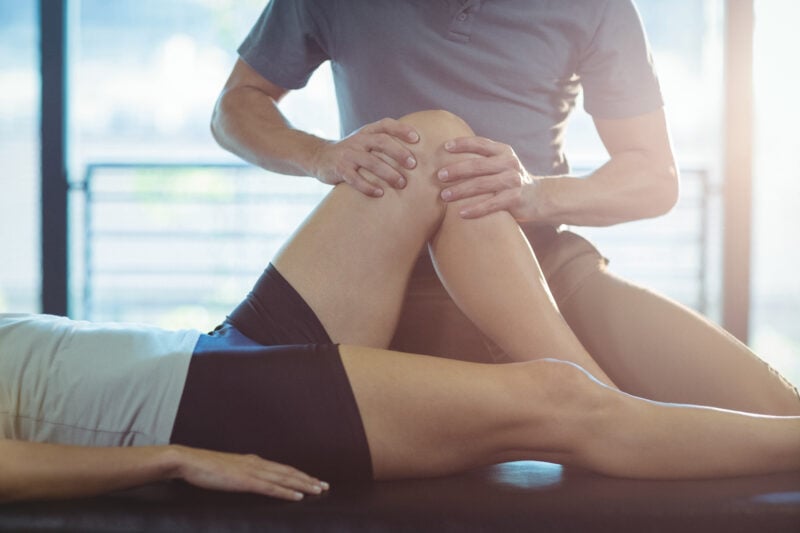
If you are dealing with knee pain due to osteoarthritis, know that you have company. An estimated 45% of people will experience knee pain due to OA at some point in their life. Physical Therapy is a well validated treatment for knee OA as evidenced by more than 50 randomized controlled trials.
Perhaps, however, you haven’t gotten the results you desire from PT or you are looking to “boost” your recovery and are considering injectables. You might be wondering, will the effects outweigh the (generally out of pocket) cost?
Some common injectables currently available are cortisone (glucocorticosteroid), hyaluronic acid (viscosupplementation), and PRP (platelet rich plasma). Each comes with advantages and disadvantages.
Corticosteroid injections have been used for many years and can be powerful pain relievers, but come with downsides. A very common treatment, 38% of people with knee OA have received at least one injection. A 2 year randomized controlled trial published in JAMA showed that cortisone injections, given every 3 months for 2 years, resulted in transient pain relief and damage to cartilaginous tissue. The pain relief provided can facilitate a person with knee OA to participate in exercises based PT to help relieve symptoms, but destruction of cartilage in an arthritic joint is a significant consideration.
Another popular injectable is viscosupplementation, more commonly known as hyaluronic acid. This year, the British Medical Journal analyzed whether HA is beneficial in knee osteoarthritis. Collecting data from multiple trials and encompassing over 21000 individuals, the researchers determined that HA did not impart a minimal clinical benefit. Due to the lack of efficacy and greater risk of adverse effects than placebo, this treatment is not recommended for knee OA.
PRP (platelet rich plasma) is generally safer than other injectables because it is autologous (meaning it is derived from the patient’s own body). A blood sample is taken from the patient, which is then centrifuged and injected into the affected joint. The data shows that correct dosing is key to a successful treatment; a minimum of 10 billion platelets is critical. Though the exact mechanism for why PRP works remains to be determined, recent randomized controlled trials have shown a superior clinical benefit from PRP over corticosteroids/cortisone or hyaluronic acid injections.
This is just a brief summary of some treatments that are available and is meant to provide an overview. Please discuss any treatment options with your orthopedist, who will be able to give greater context to your specific needs.
Farrokhi, S., Voycheck, C. A., Tashman, S., & Fitzgerald, G. K. (2013). A biomechanical perspective on physical therapy management of knee osteoarthritis. Journal of Orthopaedic & Sports Physical Therapy, 43(9), 600–619. https://doi.org/10.2519/jospt.2013.4121
Fransen M, , McConnell S, , Harmer AR, , Van der Esch M, , Simic M, , Bennell KL. and Exercise for osteoarthritis of the knee. Cochrane Database Syst Rev. 2015; 1: CD004376
Deyle, G. D., Allen, C. S., Allison, S. C., Gill, N. W., Hando, B. R., Petersen, E. J., Dusenberry, D. I., & Rhon, D. I. (2020). Physical therapy versus glucocorticoid injection for osteoarthritis of the knee. New England Journal of Medicine, 382(15), 1420–1429. https://doi.org/10.1056/nejmoa1905877
McAlindon, T. E., LaValley, M. P., Harvey, W. F., Price, L. L., Driban, J. B., Zhang, M., & Ward, R. J. (2017). Effect of intra-articular triamcinolone vs saline on knee cartilage volume and pain in patients with knee osteoarthritis. JAMA, 317(19), 1967. https://doi.org/10.1001/jama.2017.5283
Pereira, T. V., Jüni, P., Saadat, P., Xing, D., Yao, L., Bobos, P., Agarwal, A., Hincapié, C. A., & da Costa, B. R. (2022). Viscosupplementation for knee osteoarthritis: Systematic review and meta-analysis. BMJ. https://doi.org/10.1136/bmj-2022-069722


